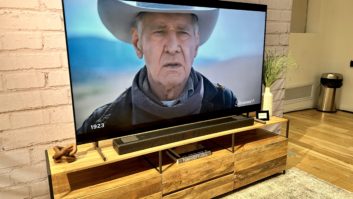#CES Las Vegas – Sony’s
top management detailed its 2012 TV and content market strategies during an
international media roundtable Monday morning, a day after its International
CES press event, here.
Sony Electronics’
Howard Stringer, chairman, CEO and president; Kaz Hirai, executive deputy
president and officer in charge of consumer products and service businesses;
and Sony Electronics’ U.S. president/COO Phil Molyneux fielded questions all
things TV and Sony’s special role in providing entertainment content via TV,
tablets, smartphones, PCs and PlayStation.
Stringer began the
roundtable by saying Sony has a three-pronged strategy – “networking, products
and content” – and how they work together. “Can we get them right? That’s what
we are working on.”
Molyneux said that
for consumers in the U.S. who have high expectations for networked TVs, “we
have some work to do to make a connectable TV a lot simpler to operate and
provide greater support.”
When asked if
there was any serious discussion in the past year, as reported several times,
that Sony was considering an exit from the TV business, Stringer said, “We have
no plans to get out of the TV business. We did discuss how to cut commoditization
… and make it a good business. We feel it is by delivering unique content to
the TV in the home, and we have to sustain it … to find profitability. The TV
screen is still the most powerful screen with the audience.”
When asked if
Sony’s TV business will be profitable by March 2014 as projected by the
company, Hirai expects it to be and said, “Our new crystal LED technology we
are showing [at CES] will figure into it.” Dissolving its flat-panel
partnership with Samsung will save 50 billion yen, he said, and Sony is looking
to “right-sizing our line, and increasing our TV share in overseas markets. We
want to make sure we have an efficient line and not an overlapping line of
TVs.”
3D was supposed to
be a major driver in the TV market since its introduction in 2010, and Hirai
commented, “As with any new technology, it will take [time] before all TVs
become 3D compatible. More content is becoming available,” and he mentioned
game software and movies such as Sony’s own “Men In Black 3” to debut in
theaters later this year. “Customers who have experienced 3D enjoy it. We are
committed to 3D … and backing it with a lot of R&D support.”
When asked why Sony
turned to crystal LED vs. OLED in flat screens, Stringer said, “It is the best
TV out there and it is our technology. We are proud of it – it is in the high
end where we will lead the [category’s] recovery. We are proud that it is
something of our own.”
Hirai added that
Sony has OLED on the pro side and that “as much as we are proud of the crystal
screen, we are not out of OLED. We will continue to look at it, but there is
nothing to talk about now.”
When asked about
the possible threat an Apple TV might be to the existing market, Stringer
noted, “Early in this century Apple married hardware and content more
effectively than we have. What our position is that [the market] doesn’t need
another box from Apple. Sony can provide a seamless experience with our TVs,
Blu-ray players … PlayStation to provide [Sony] content. We have to make that
clear to customers and get consumers excited. We are in the game.”
Hirai said that
Sony’s strategy for enjoying content is a “four-screen strategy of TVs, PCs,
tablets and smartphones.” Phones will be part of it since Sony Ericsson, now
called Sony Mobile Communications, is now a full subsidiary of Sony and is “fully
aligned” which means “all product development in one group and especially for
networked products.” And PlayStation and the handheld Vita device are also “important
to Sony convergence story and profitability … it is very pivotal.”
Hirai said that it
is the task of Sony, and the CE industry, to explain to consumers the
advantages of smart TVs. “We have to let consumers know that connecting TVs
online allows for additional content. When consumers first bought PCs, they
connected the power line and then online. We have to explain to consumers that
today’s TVs should be the same … which improves content … and creates
excitement.”













